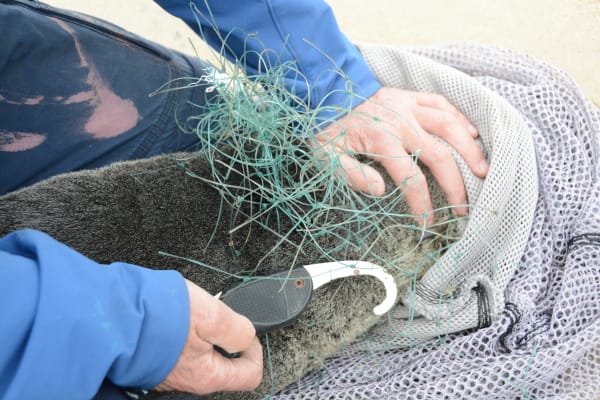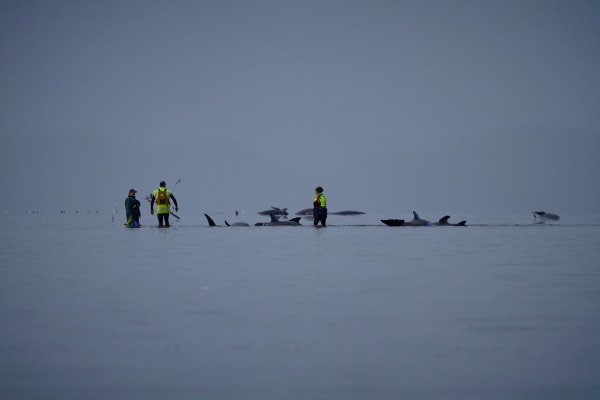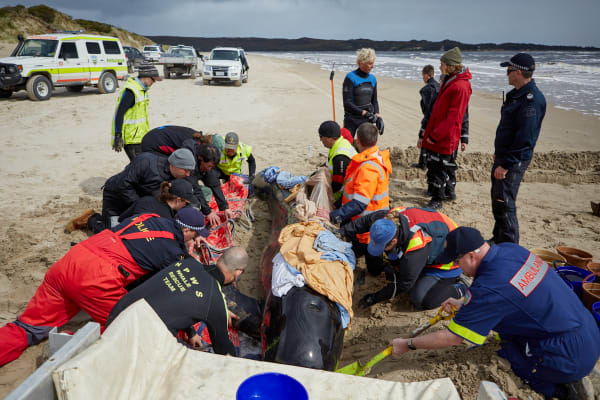“The shores of Van Diemen’s Land are the resort, at certain seasons, of the whale, which proceeds thither for the purpose of calving in the numerous bays with which the island is indented. The whale is of the black species; and at the various bays there are whaling establishments belonging to the merchants of Hobart Town or Launceston.”
~ W H Leigh Reconnoitering Voyages and Travels with Adventures in the New Colonies of South Australia, 1840 (in reference to the southern right whale)
Tasmania is a world-class theatre when it comes to watching marine mammals and birds in the wild. Sitting between the Southern Ocean and the bottom of the East Australian Current, the waters around Tasmania are home to many species that are hard to find elsewhere. For some locals, spotting dolphins, seals and albatrosses as they walk along southern coastlines or drive a boat around Maria Island can be a routine experience.
More than 30 species of whales have been recorded in Tasmanian waters. The most common sightings tend to be whales that travel near the surface and close to the coast, such as humpbacks, orcas and right whales, but even sperm and blue whales have been spotted nearby.

Sadly, the species historically most common in Tasmanian waters, the southern right whale, is now one of the most endangered. Until the arrival of Europeans, the waters around our state abounded with southern right whales. One early colonial wrote that they struggled to sleep at night because of the sound of whales in the River Derwent. Yet within the 50 years of the settlement, the blood of whales had been spilt in gallons.
Whale blubber, baleen and bone were valuable commodities at the time and many colonists found their fortune in the bodies of whales off the Tasmanian coast. While any whale was a prize, the southern right whales that swam slowly close to shore were the easiest targets. They were killed in their thousands along our coasts until the 1840s, when they had been driven to near-extinction and whalers were forced to move on. Even their name serves as a grim reminder – they were so-called because they were “the right whale to hunt.”
As whale populations dramatically declined around the globe, the unsustainable and exploitative nature of whale hunting became evident, rising to a head in the 1970s when awareness and protest movements resulted in a broad realization and acceptance that whales as a species were worth more than the sum of their parts.
Tasmania was no exception. In 1989 Princess Pauline Melikoff, a Tasmanian who married an exiled Russian prince and lived in Hobart for many years, established a trust fund. Part of it was dedicated to St Ann’s Homes for the Aged, but the rest was committed to the Tasmanian wildlife protection services. In accordance with her wishes, this led to the birth of what is known today as the Marine Conservation Program, or MCP.
One of the key members of the program, Kris Carlyon, told me that, “The MCP sits within the Natural and Cultural Heritage Division of DPIPWE (Department of Primary Industries, Parks, Water and Environment). We’re a team of five biologists and, basically, our work involves monitoring and management of marine mammals and seabirds in Tasmania. That’s dolphins, whales, seals, albatross, petrels and a few others.”

Biologists at the MCP are also the main point of call for marine creatures found injured or at-risk across Tasmania. These incidents include net entanglements, seals wandering onshore and whale or dolphin strandings, but the possibilities are endless. Every incident is different and the MCP is prepared to respond as soon as a call is received.
Part of the MCPs work is understanding why these events occur, and whale and dolphin strandings in particular can be caused by all sorts of factors. Sometimes an individual is sick or injured and left behind, or a navigator may lose their way along complicated coastlines and lead the pod astray. They can be influenced by human activity but, according to Carlyon, the majority of causes are natural.
Alongside the DPIPWE biologists, there are hundreds of volunteers around Tasmania who have participated in marine rescues. The MCP encourages people interested in being involved to attend a whale rescue awareness session. These deal with risks such as hypothermia and dealing with heavy machinery and large, powerful animals. Anyone physically able is welcome to become involved, but it’s especially practical for residents of coastal towns who may happen across a stranding or other issue.
Jo Malcolmson and James Stone live at South Arm and are typical of resident volunteers. Sitting at the end of a complex peninsula with fast and low tides, South Arm is another area prone to marine mammal incidents. Jo and James received training years ago, and they have witnessed many incidents “due to their address”.
“Incidents are going to happen,” said Jo. “It’s almost an obligation to … get involved; to appreciate where you live, what’s on your doorstep.”
Jo Malcolmson feels that, regardless of experience, resourcefulness and a willingness to help are the most important qualities in a potential volunteer.

. . .
During the course of my research on whales and other marine creatures in Tasmania, an extraordinary event occurred which cast the work of the MCP and the broader DPIPWE into sharp relief across the world. In late 2020, about 470 long-finned pilot whales were found stranded in Macquarie Harbour on Tasmanian’s west coast. Strandings are relatively common in this state, but an incident on this scale is impossible to predict. The day after the MCP arrived, I made the four-hour trip from Hobart to witness the event personally.
Thirty-minutes from Strahan at Macquarie Heads, the small dock was bustling with cars, equipment and people. By foot, you could make your way along Macquarie Heads Road all the way to Hell’s Gates, where local residents stood watching the disaster unfold. Some had been watching since the night before.
About 200 metres from the road, a cluster of people in wetsuits stood knee-deep along the sandbar that separates the heads. With the sun glittering off the water, it would have been picturesque if not for the slew of dark fins protruding weakly from the water. Fishing boats with complex roping on their sides for carrying the animals to open water drove by, and the sound of slapping fins and whale cries reached us across the shore.
One of the onlookers shook her head sadly at me. “Those poor things,” she murmured.

Regardless of one’s neighbourhood, experience or occupation, the more I spoke to people the more I noticed an incredible and universal ambition to aid and protect whales and other creatures of the sea. I asked Kris Carlyon why he believes people react so passionately to the work he does, and he paused for a moment to consider.
“I think whales in particular, but also some of the other species, are still a bit of a mystery. They’re obviously really intelligent species, and I think we identify with them to a degree. And people feel their suffering.
“Even though I have a bit more exposure, it’s still a rare chance to see some of these things in the flesh, standing with live whales, in and around you and being able to interact with them and seeing them react to you. Seeing our southern right whales up close and hearing them vocalise, and smelling their breath, is something no-one gets to experience often.”
Beyond the mystique and awe these leviathans of the sea seem to leave us in, there seems to be a part of us as humans that recognises and empathises with dolphins and whales. Despite how little we understand them, there is something mystifying about how seldom they breach the surface and how we feel when they do. We know they’re intelligent beings and that, like us, they have strong social bonds, and even though we can’t be certain they feel emotions the same way, we can sense a connection.
We have to wonder whether those who exploited them by the thousands could sense the same intelligence and sensibility.

Besides getting in the water, there are other ways in which we can all contribute to the protection and conservation of our marine wildlife. Killer Whales Australia and the Happywhale Project are both programs that rely on photo contributions to monitor orcas and humpback whales respectively in Australia. And if you’re in Tasmania and you spot a whale or other marine animal, including any in distress, the MCP can be reached on the hotline 0427 WHALES (0427 942 537).
You can read more about the Marine Conservation Program at dpipwe.tas.gov.au.
Isabel Howard is a homegrown writer and creative living in Hobart. She is passionate about the environment and cultural diversity. She recently finished an undergraduate degree in English and Japanese, and is interested in continuing study in international politics and writing.







